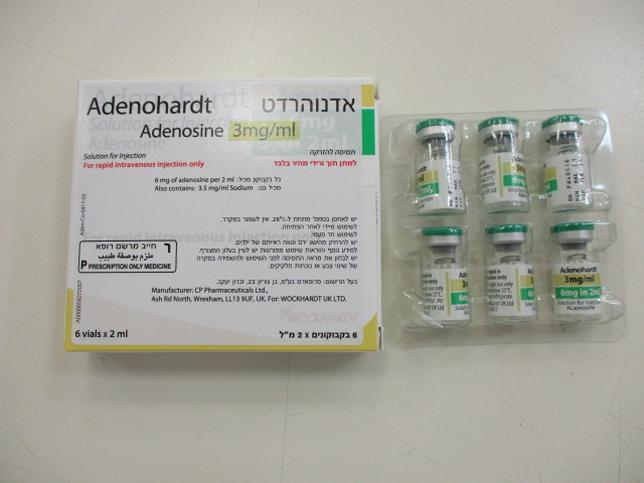Quest for the right Drug

אדנוהרדט ADENOHARDT (ADENOSINE)
תרופה במרשם
תרופה בסל
נרקוטיקה
ציטוטוקסיקה
צורת מתן:
תוך-ורידי : I.V
צורת מינון:
תמיסה להזרקה : SOLUTION FOR INJECTION
עלון לרופא
מינוניםPosology התוויות
Indications תופעות לוואי
Adverse reactions התוויות נגד
Contraindications אינטראקציות
Interactions מינון יתר
Overdose הריון/הנקה
Pregnancy & Lactation אוכלוסיות מיוחדות
Special populations תכונות פרמקולוגיות
Pharmacological properties מידע רוקחי
Pharmaceutical particulars אזהרת שימוש
Special Warning עלון לרופא
Physicians Leaflet
Special Warning : אזהרת שימוש
4.4 Special warnings and precautions for use Special warnings Due to the possibility of transient cardiac arrhythmias arising during conversion of the supraventricular tachycardia to normal sinus rhythm, administration should be carried out in a hospital setting with monitoring and cardio-respiratory resuscitation equipment available for immediate use if necessary. During administration, continuous ECG monitoring is necessary as life threatening arrhythmia might occur (see section 4.2). Because it has the potential to cause significant hypotension, adenosine should be used with caution in patients with left main coronary stenosis, uncorrected hypovolemia, stenotic valvular heart disease, left to right shunt, pericarditis or pericardial effusion, autonomic dysfunction or stenotic carotid artery disease with cerebrovascular insufficiency. There have been reports of cerebrovascular accident/transient ischemic attack, secondary to the haemodynamic effects of adenosine. There have been reports of myocardial infarction shortly after use of Adenohardt. Adenosine should be used with caution in patients with recent myocardial infarction, severe heart failure, or in patients with minor conduction defects (first degree A-V block, bundle branch block) that could be transiently aggravated during infusion. Adenosine should be used with caution in patients with atrial fibrillation or flutter and especially in those with an accessory by-pass tract since particularly the latter may develop increased conduction down the anomalous pathway. Rare cases of severe bradycardia have been reported. Some occurred in early post-heart transplant patients; in the other cases, occult sino-atrial disease was present. The occurrence of severe bradycardia should be taken as a warning of underlying disease and could potentially favour the occurrence of torsades de pointes especially in patients with prolonged QT intervals. In patients with recent heart transplantation (less than 1 year), an increased sensitivity of the heart to adenosine has been observed. Since neither the kidney nor the liver are involved in the degradation of exogenous adenosine, Adenohardt’s efficacy should be unaffected by hepatic or renal insufficiency. As dipyridamole is a known inhibitor of adenosine uptake, it may potentiate the action of Adenohardt. It is therefore suggested that Adenohardt should not be administered to patients receiving dipyridamole. If use of Adenohardt is essential, dipyridamole should be stopped 24 hours, or the dose of adenosine should be greatly reduced (see section 4.5). Precautions The occurrence of angina, severe bradycardia, severe hypotension, respiratory failure (potentially fatal), or asystole/cardiac arrest (potentially fatal) should lead to immediate discontinuation of administration. Adenosine may trigger convulsions in patients who are susceptible to convulsions. In patients with history of convulsions/seizures, the administration of adenosine should be carefully monitored. Because of the possible risk of torsades de pointes, Adenohardt should be used with caution in patients with a prolonged QT interval, whether this is drug-induced or of metabolic origin. Adenohardt is contraindicated in patients with long QT syndrome (see section 4.3). Adenosine may precipitate or aggravate bronchospasm (see sections 4.3 and 4.8). Adenohardt contains less than 1 mmol sodium (23 mg) per injection vial (2 ml), that is to say. essentially 'sodium-free'.
Effects on Driving
4.7 Effects on ability to drive and use machines Not applicable.

שימוש לפי פנקס קופ''ח כללית 1994
לא צוין
תאריך הכללה מקורי בסל
01/03/2001
הגבלות
תרופה מוגבלת לרישום ע'י רופא מומחה או הגבלה אחרת
מידע נוסף
